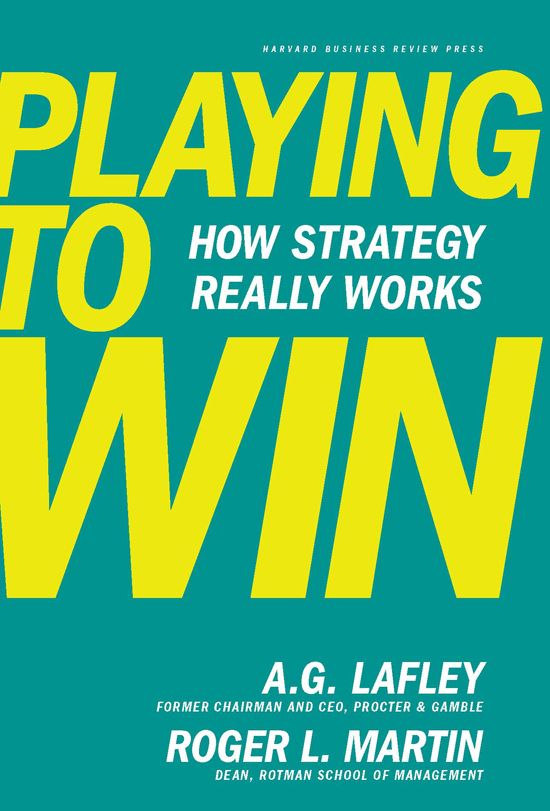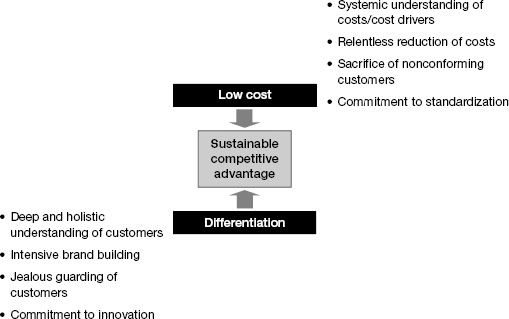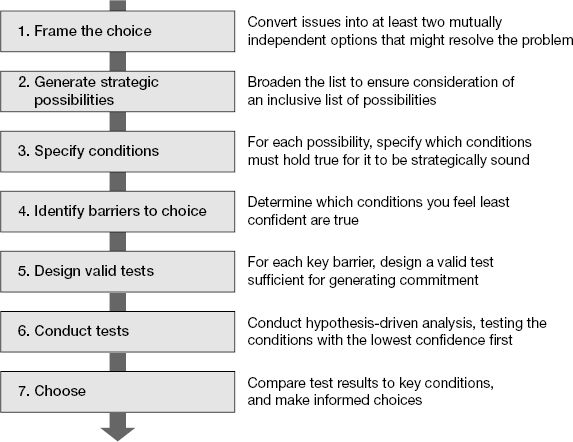Playing to Win: How Strategy Really Works - Lafley, A.G.

## Metadata
- Author: **Lafley, A.G.**
- Full Title: Playing to Win: How Strategy Really Works
- Category: #books
## Highlights
- More specifically, *strategy is an integrated set of choices that uniquely positions the firm in its industry so as to create sustainable advantage and superior value relative to the competition*. ([View Highlight](https://read.readwise.io/read/01jjxb56j0p0t9td0fc5xd8v9s))
## New highlights added February 1, 2025 at 7:17 AM
- Olay took the leap to $18.99 for the launch of Olay Total Effects. It was set as the manufacturer suggested retail price, and the team worked hard to convince retailers to stick to that price.
Momentum started to build. Olay followed up with an even more expensive premium brand, with a yet-better active ingredient: Olay Regenerist. Then, it introduced Olay Definity and then the still-higher premium Olay Pro-X—which sold at a $50 price point, something inconceivable ten years earlier. ([View Highlight](https://read.readwise.io/read/01jk101xg8z7xkae6xxq4szm19))
- Strategy can seem mystical and mysterious. It isn’t. It is easily defined. It is a set of choices about winning. Again, it is an integrated set of choices that uniquely positions the firm in its industry so as to create sustainable advantage and superior value relative to the competition. Specifically, strategy is the answer to these five interrelated questions:
1. *What is your winning aspiration?* The purpose of your enterprise, its motivating aspiration.
2. *Where will you play?* A playing field where you can achieve that aspiration.
3. *How will you win?* The way you will win on the chosen playing field.
4. *What capabilities must be in place?* The set and configuration of capabilities required to win in the chosen way.
5. *What management systems are required?* The systems and measures that enable the capabilities and support the choices. ([View Highlight](https://read.readwise.io/read/01jk105sy6ps8gs7y7vjamhcxv))
- Where to play represents the set of choices that narrow the competitive field. ([View Highlight](https://read.readwise.io/read/01jk10w1eznrk59rwd9j7xd9pw))
- Olay made two strategically decisive where-to-play choices: to create, with retail partners, a new masstige segment in mass discount stores, drugstores, and grocery stores to compete with prestige brands and to develop a new and growing point-of-entry consumer segment for anti-aging skin-care products. ([View Highlight](https://read.readwise.io/read/01jk10vpv23yekc7drcxkcgpdd))
- Core consumers were a theme too; we pushed businesses to focus on the consumer who matters most, targeting the most attractive consumer segments. ([View Highlight](https://read.readwise.io/read/01jk10x0g4c0nt4h6f914z1ysw))
## New highlights added February 3, 2025 at 7:36 AM
- Where to play selects the playing field; how to win defines the choices for winning on that field. ([View Highlight](https://read.readwise.io/read/01jk50vmq91jtgdjh21sa8dn87))
- To determine how to win, an organization must decide what will enable it to create unique value and sustainably deliver that value to customers in a way that is distinct from the firm’s competitors. Michael Porter called it competitive advantage—the specific way a firm utilizes its advantages to create superior value for a consumer or a customer and in turn, superior returns for the firm. ([View Highlight](https://read.readwise.io/read/01jk5140q4812jp7r06hdb4wk9))
- Bob Young, cofounder of Red Hat, Inc., knew precisely where he wanted his company to play: he wanted to serve corporate customers with open-source enterprise software. In his view, the how-to-win in that context required scale—Young saw that corporate customers were much more likely to buy from a market leader, especially a dominant market leader. At the time, the Linux market was highly fragmented, with no such clear leader. Young had to change the game—by literally giving his software away via free download—to achieve dominant market share and become credible to corporate information technology (IT) departments. In that case, Young decided where to play and how to win, and then built the rest of his strategy (earning revenue from service rather than software sales) around these two choices. The result was a billion-dollar company with a thriving enterprise business. ([View Highlight](https://read.readwise.io/read/01jk51kdpc6z3jqb5f67fz6eq5))
-  ([View Highlight](https://read.readwise.io/read/01jk5277cg3xkd891gntymtvw0))
- All successful strategies take one of these two approaches, cost leadership or differentiation. Both cost leadership and differentiation can provide to the company a greater margin between revenue and costs than competitors can match—thus producing a sustainable winning advantage ([figure 4-1](private://read/01jjg9yaemn9ky2zkehe45e5y6/#c004F01)). This is ultimately the goal of any strategy. ([View Highlight](https://read.readwise.io/read/01jk64dwafe60rztrvf6jwgfh0))
-  ([View Highlight](https://read.readwise.io/read/01jk64gw5vykpgf2ajv5mm70h3))
## New highlights added February 3, 2025 at 4:56 PM
- Do work to create new how-to-win choices where none currently exist. Just because there isn’t an obvious how-to-win choice given your current structure doesn’t mean it is impossible to create one (and worth it, if the prize is big enough). ([View Highlight](https://read.readwise.io/read/01jk74qk2mg4qnwqq8k9ka99q9))
- But don’t kid yourself either. If, after lots of searching, you can’t create a credible how-to-win choice, find a new playing field or get out of the game. ([View Highlight](https://read.readwise.io/read/01jk74s2s8xb2mxevpe8gjr32j))
- Do consider how to win in concert with where to play. The choices should be mutually reinforcing, creating a strong strategic core for the company. ([View Highlight](https://read.readwise.io/read/01jk74v22g9yxexmaj4kng7209))
- Don’t assume that the dynamics of an industry are set and immutable. The choices of the players within those industries may be creating the dynamics. Industry dynamics might be changeable. ([View Highlight](https://read.readwise.io/read/01jk74w3by81sv16hxtkjzxq1c))
- Don’t reserve questions of where to play and how to win for only customer-facing functions. Internal and support functions can and should be making these choices too. ([View Highlight](https://read.readwise.io/read/01jk74wshbjnepxm9xdqry06et))
- Do set the rules of the game and play the game better if you’re winning. Change the rules of the game if you’re not. ([View Highlight](https://read.readwise.io/read/01jk74xtk1gz2tpgt86avj9dta))
- The company launched the new diaper as Pampers.[a](private://read/01jjg9yaemn9ky2zkehe45e5y6/#c04-fn-01) Throughout the rest of the 1960s and the 1970s, Pampers built significant unit volume and dollar sales by converting cloth-diaper users to disposables users. P&G effectively created a new category and easily won a leading share in it. Looking back, the Pampers story is a great example of strategic insight and vision. A better product fulfilled an unmet consumer need, delivered a better user experience, and created better total consumer value. ([View Highlight](https://read.readwise.io/read/01jk756cf3w89kgp6sb8scth8f))
## New highlights added February 4, 2025 at 8:31 AM
- Unfortunately, the company had miscalculated. While consumers virtually always say they won’t buy (or even try) an improved product if it is sold at a higher price, those same consumers often change their minds when the product and usage experience are clearly better and the price premium still represents value. This turned out to be the case with shaped diapers, and Pampers suffered. ([View Highlight](https://read.readwise.io/read/01jk8n9nt3mn48h9bc6abft04k))
-  ([View Highlight](https://read.readwise.io/read/01jk8rv940rg06wr6majebxqz2))
- Framing the issue as a choice identifies a preliminary set of options for resolving the problem; the next task is to broaden the list of possibilities. The objective in this step is to be inclusive rather than restrictive of the number and diversity of possibilities on the table. ([View Highlight](https://read.readwise.io/read/01jk8s0z6yjpd8y11ehcsy1a5v))
## New highlights added February 5, 2025 at 7:57 AM
- Do frame a clear and important choice up front; make it real and significant. ([View Highlight](https://read.readwise.io/read/01jka9f4f9ggfkk73tnp6kj5s4))
- Do explore a wide range of where-to-play and how-to-win possibilities, rather than narrowing the list early on to those that feel realistic; unexpected possibilities often have interesting and helpful elements that can otherwise be dismissed out of hand. Learn from them. ([View Highlight](https://read.readwise.io/read/01jka9ragqg3619xx5marm6j8c))
- Do stay focused on the most important question (what would have to be true for this to be a winning possibility?), listing the conditions under which this possibility would be a really good one. ([View Highlight](https://read.readwise.io/read/01jka9s2be3h6yhtn96vray93s))